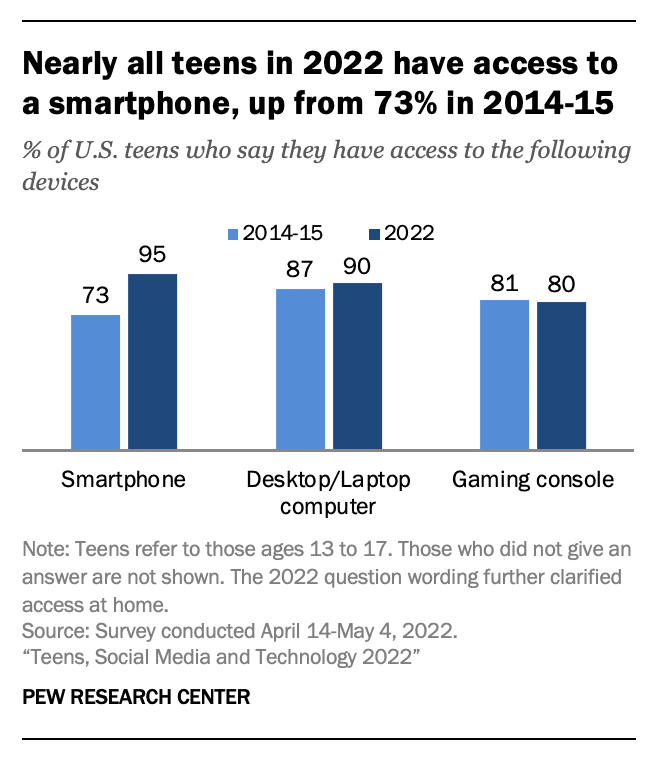Millennials are the group every church is trying to reach, but struggling to do it successfully. Using statistics about millennials helps you to better understand who they are and what they want from a church.
Despite being a generation that may have been raised in the church, many of them have quit attending. However, they’re growing up now and have families of their own.
If you want to reach an even younger generation, it all starts with the millennial generation. Much like baby boomers, Gen X, and past generations before them, their views on the world are changing things. That includes church.
So how can we reach them? Let’s find out.
Estimated reading time: 15 minutes
Table of contents
Reaching Millennials

Millennials, born roughly between the early 1980s and mid-1990s, represent a significant demographic group shaping today’s social, economic, and cultural landscape. Understanding their characteristics and behaviors is crucial for reaching them.
First Generation Millennials
The first generation of millennials, often termed as “pioneers” of the digital age, grew up witnessing the rapid evolution of technology. They were the first to embrace the internet, social media, and mobile devices, which profoundly influenced their communication styles, preferences, and consumption habits.
This tech-savvy cohort seeks authenticity and meaningful connections in both personal and professional realms. They value experiences over material possessions, driving trends like the sharing economy and sustainable living. To effectively reach millennials of this group, churches must leverage digital platforms, engage in transparent communication, and offer innovative solutions that resonate with their values and aspirations.
Millennial Women
Millennial women constitute a dynamic and empowered segment of this generation, challenging traditional gender roles and stereotypes. They are more likely to pursue higher education and enter the workforce, striving for career advancement and equal opportunities.
Millennial women prioritize work-life balance, family, and personal fulfillment, seeking employers that support flexible schedules and inclusive policies. As consumers, they wield significant purchasing power, influencing trends in fashion, wellness, and social activism.
To engage millennial women effectively, churches should adopt inclusive messaging, represent diverse perspectives, and address issues like gender equality and representation. Empowering millennial women as leaders and decision-makers is key to driving positive change in workplaces and communities.
Millennial Men
In the past year, churches have been increasingly focusing on reaching out to millennial men, recognizing their importance in shaping communities and spiritual engagement. This demographic, surpassing baby boomers in numbers, presents both challenges and opportunities for churches seeking to connect with them.
To effectively reach millennial men, churches are adopting inclusive approaches that resonate with their interests and values. They are incorporating technology, such as live streaming and social media, to engage this tech-savvy generation.
Additionally, churches are creating welcoming environments that encourage authentic relationships and meaningful discussions. Emphasizing relevant topics like personal growth, relationships, and community involvement helps to capture the attention of millennial men and address their spiritual needs.
By understanding the unique perspectives and preferences of millennial men, churches can create meaningful connections that foster spiritual growth and community involvement. This proactive approach ensures that churches remain relevant and impactful in the lives of millennials, nurturing a vibrant and inclusive faith community for generations to come.
Stats on Millennials

Let’s go over a collection of stats so we can better understand millennials and figure out how to connect with them and get them to church. Older generations need to understand how different millennials can be from them, and approach them with grace and understanding, rather than with judgment.
We hope these statistics are able to help your church reach millennials better than ever. Let’s jump in.
What Do Millennials Believe In?
It’s easy to get caught up in believing the entire millennial population is atheist now. It’s a common myth that may make you feel like there’s no point in trying to reach them. However, over half of millennials do identify as religious.
In this article, the Pew Research Center offers some enlightening statistics on how younger millennials (18-29) believe:
- 56% identify as Christian with Evangelical Protestant and Catholic being the most common
- 8% prefer a non-Christian faith, such as Jewish or Muslim
- 36% are unaffiliated, but only 6% are atheist.
- Among the unaffiliated millennials, 9% still say religion is important to them
- 50% of millennials believe in God with absolute certainty
- 30% believe in God, but with varying amounts of certainty
- 17% say they don’t believe at all (much lower than what you may have expected)
- 39% pray daily and 18% pray weekly
- 36% rarely or never pray
These statistics about millennials shed some hope on reaching them. Many of them do still believe in God and feel that religion is important to them. Despite all the negative church statistics you might see about young adults, the entire generation hasn’t abandoned Christianity. They just need some guidance.
Millennials Raised In Church Have Left
Odds are, your church has likely noticed this trend as millennials have gotten older. Instead of coming with their parents as kids and teens, they’re now adults. As a result, they’re starting to leave the churches they grew up in.
One millennial is trying to speak out as to why this is happening. She’s sad that 59% of millennials who were raised in church have stopped attending. However, she doesn’t particularly like church herself, even though she’s Christian.
Sadly, even though she wants to enjoy church, others don’t share her sentiment. In fact, 35% believe the church does more harm than good.
The good new is she provided a few tips as to why millennials feel this way, including:
- Asking about their needs and opinions
- They want less focus on religious-speak and more action and plain-speak gospel
- More time focused on service versus tons of meetings and groups that don’t really serve anything or anyone
- More teaching and less blaming the “culture”
- Make church feel more like a welcoming community than a closed clique
Even when discussed how to better work with millennials, it was the same theme. Millennials want a more community-focused church that teaches more through action than lengthy sermons. They also want a chance to be heard and considered a true part of the church community.
The moral of the story – churches have to find a balance between how they used to do things and how millennials prefer to do things. They want more authenticity versus flashing lights. They also want slight changes to better fit their lifestyles, such as later service times and shorter services. All in all, it’s simply a matter of making a few changes versus millennials no longer wanting religion in their lives.
Millennials Were Raised Differently

A common reason why millennials aren’t as interested in going to church as previous generations also comes down to how they were raised. Older generations were much more likely to make religion and going to church a strict part of their routine, including taking their children with them.
Boomers and Gen X often had different work schedules, worked longer hours, spent more time going to their children’s activities and had to deal with more single parents and two working parent households.
As a result, these two previous generations often felt too tired to always attend. They also were much more lenient with their kids, often letting the kids make the choices, such as not wanting to get up early on a Sunday to go to church. This has created a trending habit of less attendance as millennials grew.
Millennials’ church attendance habits growing up weren’t great as these statistics about millennials show:
- Only 29% attended services regularly with their family growing up (52% of seniors did so)
- 32% never attended church with their family while growing up
- Only 27% of millennials attended Sunday school regularly (55% of seniors did so)
As stated before, this change in attendance between young millennials and seniors is largely to blame on the culture in which they were raised. If anything, its more about the other generation than millennials. A few statistics to showcase this include:
- 47% of millennials with married parents attended services more regularly growing up
- 28% of millennials attended church services regularly when their parents were divorced
- 20% of households have parents of different religions, which leads to attending services less often
- 56% of people with parents sharing a religious background attend services regularly
- 43% of those with parents with different religious backgrounds attend services
- 35% of people who were raised in religious households, but didn’t little engagement stopped attending church as they got older
- Only 7% of people who grew up in religious households with high levels of engagement of children stopped attending church
Overall, generations have gradually stopped thinking about church attendance as important. The parents of millennials didn’t think attendance was nearly as important as their parents did. Now, millennials have children and see attending church as even less important.
As a good comparison, 76% of seniors felt it was necessary to raise a child with religion to help instill better moral values. Only 48% of young millennials feel the same way.
Millennials And Volunteering
Millennials are a generation that’s all about change. While they can come off entitled by always demanding change (even when it’s something silly like the color of a coffee cup), making positive changes in the world isn’t a bad thing.
Thanks to growing up in an age with more media immersion, millennials were able to see more about the good and the bad in the world. They likely heard their parents talking about changes that needed to be made. As a result, they’re volunteering more and more.
This is great news for your church. Millennials actually want to volunteer. How many churches right now feel short-staffed when it comes to volunteers?
Obviously, you have to attract millennials to your church first, but offering the right volunteer opportunities can help. But first, take a look at these statistics about millennials that show how they feel about volunteering:
- 90% of millennials believe they can help make the world better
- 49% of millennials are optimistic things can get better (explaining why their volunteer numbers are growing)
- 46% of millennials are more likely to volunteer if it’s a social cause they closely identify with
- Over a third of millennials volunteer at least 11 hours per year
- Gen X volunteers most with 28.9% volunteering, but millennials are growing with 21.9% volunteering
- 70% of millennials gave at least an hour of their time to a charitable cause
Millennials may tend to give less than previous generations, but this is often due to higher amounts of debt and fewer higher-paying jobs. College debt may hold them back, but they still want to help, even if that means giving time over money.
If you want to see the millennial volunteer rates by state, check out the latest data from National and Community Service which lists involvement percentages by state.
Understanding How Millennials Give
Believe it or not, millennials are considered one of the most giving generations. However, they don’t have as much money to give. This isn’t holding them back from giving what they can, though.
The biggest thing is they don’t want to give to just any nonprofit, including churches. The organizations they choose to support have to be meaningful to them. So, if your church isn’t working with causes that are important to them, they’re less likely to not only give, but to attend as well.
But, don’t write them off as stingy. Just look at how much they do give:
- Millennials give 11% of all charitable giving, despite accounting for 25.9% of the population (this is just monetary giving, though)
- 84% of millennials donate to charitable organizations, while only 59% of Gen X and 72% of Boomers do
- Millennials prefer to give online and have helped online giving increase by 7.2%
- Millennials give 33% of all donations on popular crowdfunding sites
Due to employment issues and higher amounts of debt early on like student loan debt, millennials prefer to give in different ways. Only 29% of them actually preferred donating money. Others would rather give food, clothing and other useful supplies. They also preferred volunteering.
The shift isn’t just about finances either. A change in how to give is stemming from the all too many news stories about charities misusing monetary donations. With physical supplies and volunteering, millennials feel they’re giving a more useful donation that won’t be misused.
One other very important fact is millennials are passing on their charitable nature with their children. In fact, 61% of millennial parents discuss giving with their kids and talk about the various ways and reasons to give.
Online giving is one of the more obvious ways that millennials have changed the face of giving. This applies to churches as well. A few eye-opening general millennial online giving statistics include:
- 40% of millennials who donate are part of a monthly program
- 16% give through Facebook (another reason to ensure your church is on Facebook)
- 47% of millennials used a nonprofit’s website to give
- 46% like to donate via crowdfunding platforms
Getting To Know Millennials

While you’ve gained some valuable insight through all of these statistics about millennials, it doesn’t hurt to know some more general information about them. After all, the better you understand this vital generation, the easier it’ll be to attract them to your church.
A few facts you already know include:
- They want a more community-oriented church that focuses on action and example over just preaching.
- This generation carries larger amounts of debt than previous generations, leading them to give more physical donations and time than money
- They want to be heard in church versus simply continuing to do everything the “old way.”
- Many still believe in God, but have fallen out with actual churches.
The key is showing them that your church is different and values them. Yes, it’ll likely require some compromises on both sides, but once you reach them, you’ll also reach their friends and children. So, it’s worth making a few changes to grow as a more modern church.
Reaching them will require you to know a few more statistics, such as:
- Millennials are highly engaged online and 75% share online content regularly (blog often on topics relevant to them)
- They use 3.3 Internet-connected devices daily (a digital presence is crucial to reaching them)
- 90% of millennials have a smartphone and 93% of those use it to look for things online (make sure your church site is mobile-friendly)
- 78% of millennials prefer buying experiences versus goods (consider offering getaways or things to do versus physical goods or money as fundraising prizes)
- There were 83.1 million millennials as of the last official census
The lessons to learn here are simple. Your church needs an online presence in the form of a website and at least Facebook. You also need to reach them on their phones. A website and social media presence are ideal. However, they also enjoy texts over calls.
Before you think adopting a more millennial-style strategy might alienate your older generations, consider that millennials aren’t the only tech-savvy generation. In fact, Gen X and Boomers actually helped create much of the technology millennials love.
As a quick comparison, 90% of Gen X and 68% of Boomers have smartphones. Even 40% of the Silent Generation owns a smartphone. And the new teens and young adults in your church, generation Z, have a 95% access to smartphones.

When it comes to social media, 86% of millennials, 76% of Gen X, 59% of Boomers and 28% of the Silent Generation use it.
Adding more technology and internet to your church’s engagement strategy helps you reach every generation.
Millennials aren’t as difficult to reach as you might think. Contact us today to start with an engaging website that showcases how your church helps them explore their faith in new ways and works well with the community.
Church for Millennials

Reaching millennials is not just a trend for churches; it’s a necessity for their survival and relevance in today’s ever-changing world. By embracing inclusivity, leveraging technology, and fostering authentic connections, churches can effectively engage this diverse and dynamic generation.
Whether it’s through relevant messaging, welcoming environments, or innovative outreach programs, the key lies in understanding and addressing the unique needs and aspirations of millennials. As the largest living generation, millennials wield significant influence and represent the future of faith communities.
By prioritizing their engagement and involvement, churches can ensure their continued growth and impact for years to come. It’s not about simply attracting millennials through flashy gimmicks; it’s about building meaningful relationships and creating spaces where they feel valued, supported, and inspired to grow spiritually.
In doing so, churches not only enrich the lives of millennials but also strengthen their own foundations, fostering vibrant and inclusive communities that transcend generational boundaries. As churches adapt and evolve to meet the changing needs of society, the journey of reaching millennials is not just a mission—it’s a transformative opportunity to embody the timeless values of love, acceptance, and hope for a brighter future.
We pray your church is able to continue to spread the love of Jesus to all generations. God bless!




